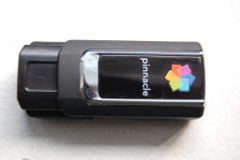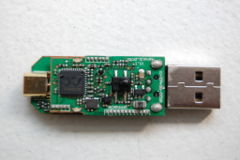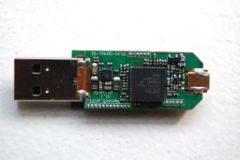Pinnacle PCTV HD Mini Stick (80e): Difference between revisions
Jump to navigation
Jump to search
(No CityK, it does *NOT* support NTSC) |
m (Well then, DH, that would certainly mean its NOT a hybrid! heheheee) |
||
| Line 1: | Line 1: | ||
[[Image:PCTV 80e Top.JPG|thumb|240px|Pinnacle PCTV HD mini Stick (80e)]] |
[[Image:PCTV 80e Top.JPG|thumb|240px|Pinnacle PCTV HD mini Stick (80e)]] |
||
A |
A [[ATSC]] [[ATSC USB Devices|USB 2.0 device]] by [[Pinnacle]]. |
||
It not supported under Linux, and is not expected to be (see [[Pinnacle_PCTV_HD_Mini_Stick_(80e)#Making_It_Work|below]]). |
It not supported under Linux, and is not expected to be (see [[Pinnacle_PCTV_HD_Mini_Stick_(80e)#Making_It_Work|below]]). |
||
==Overview/Features== |
==Overview/Features== |
||
An USB TV Tuner that supports 8-VSB and QAM. |
|||
The unit ships with an IR remote control & telescopic antenna. |
The unit ships with an IR remote control & telescopic antenna. |
||
Revision as of 22:34, 16 February 2009
A ATSC USB 2.0 device by Pinnacle.
It not supported under Linux, and is not expected to be (see below).
Overview/Features
An USB TV Tuner that supports 8-VSB and QAM. The unit ships with an IR remote control & telescopic antenna.
Components Used
| Manufacturer | IC Part # | Function | I²C address | GPIO(s) |
|---|---|---|---|---|
| Philips / NXP | TDA18271 C2 | Tuner | 0xc0 | n/a |
| Micronas | DRX 3933J | 8VSB / QAM Digital Demodulator [1] | 0x52 | reset=6 |
| Empia | EM2874 | USB Bridge | n/a | n/a |
| EEPROM | 0xa0 | n/a | ||
| LED | n/a | active=7 |
Identification
USB Subsystem ID is: 2304:023f.
Output of lsusb -v:
Bus 007 Device 003: ID 2304:023f Pinnacle Systems, Inc. [hex]
Device Descriptor:
bLength 18
bDescriptorType 1
bcdUSB 2.00
bDeviceClass 0 (Defined at Interface level)
bDeviceSubClass 0
bDeviceProtocol 0
bMaxPacketSize0 64
idVendor 0x2304 Pinnacle Systems, Inc. [hex]
idProduct 0x023f
bcdDevice 1.00
iManufacturer 1 Pinnacle Systems
iProduct 2 PCTV 80e
iSerial 3 123456789012
bNumConfigurations 1
Configuration Descriptor:
bLength 9
bDescriptorType 2
wTotalLength 41
bNumInterfaces 1
bConfigurationValue 1
iConfiguration 0
bmAttributes 0x80
(Bus Powered)
MaxPower 500mA
Interface Descriptor:
bLength 9
bDescriptorType 4
bInterfaceNumber 0
bAlternateSetting 0
bNumEndpoints 1
bInterfaceClass 255 Vendor Specific Class
bInterfaceSubClass 0
bInterfaceProtocol 0
iInterface 0
Endpoint Descriptor:
bLength 7
bDescriptorType 5
bEndpointAddress 0x84 EP 4 IN
bmAttributes 1
Transfer Type Isochronous
Synch Type None
Usage Type Data
wMaxPacketSize 0x0000 1x 0 bytes
bInterval 1
Interface Descriptor:
bLength 9
bDescriptorType 4
bInterfaceNumber 0
bAlternateSetting 1
bNumEndpoints 1
bInterfaceClass 255 Vendor Specific Class
bInterfaceSubClass 0
bInterfaceProtocol 0
iInterface 0
Endpoint Descriptor:
bLength 7
bDescriptorType 5
bEndpointAddress 0x84 EP 4 IN
bmAttributes 1
Transfer Type Isochronous
Synch Type None
Usage Type Data
wMaxPacketSize 0x03ac 1x 940 bytes
bInterval 1
Device Qualifier (for other device speed):
bLength 10
bDescriptorType 6
bcdUSB 2.00
bDeviceClass 0 (Defined at Interface level)
bDeviceSubClass 0
bDeviceProtocol 0
bMaxPacketSize0 64
bNumConfigurations 1
Device Status: 0x0000
(Bus Powered)
Making It Work
Not supported (and probably never will be).
On November 27, 2008 Micronas informed the developer who was doing the integration (Devin Heitmueller) that he would not be permitted to release the completed drx-j driver due to concerns of "trade secrets, competitor access and support" (the Linux driver incorporated reference driver source code provided by Micronas).


